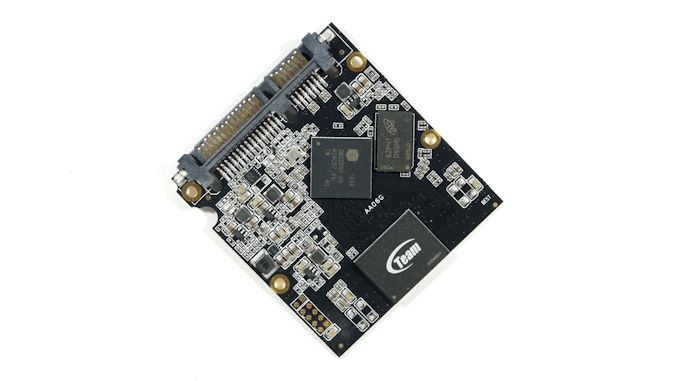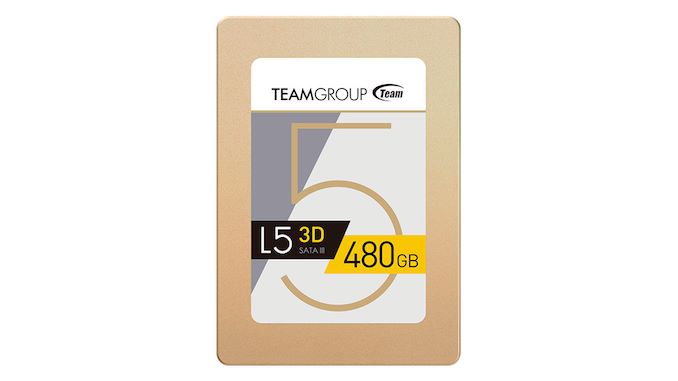
Original Link: https://www.anandtech.com/show/14874/the-team-l5-lite-3d-sata-ssd-review
The TeamGroup L5 LITE 3D (480GB) SATA SSD Review: Entry-Level Price With Mainstream Performance
by Billy Tallis on September 20, 2019 9:00 AM EST- Posted in
- SSDs
- SATA
- Silicon Motion
- SM2258
- TeamGroup
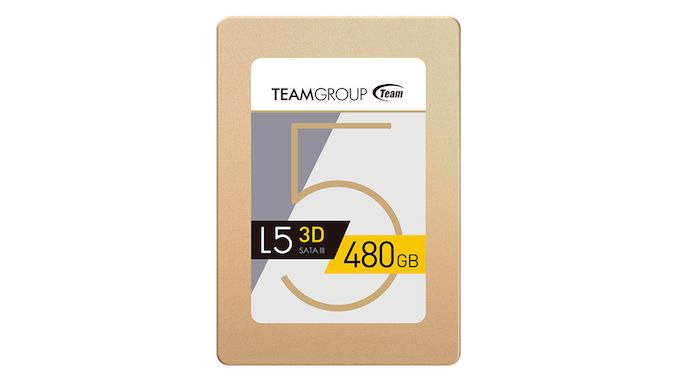
This year, the SSD market has been rather sedate. After dramatic price crashes in 2018, the market has leveled out and retail SSD prices have been fairly consistent for months. Only a handful of products have launched using the new 9x-layer 3D NAND, and there's been just one major new SSD controller launch so far in 2019. The whole industry is gearing up for the PCIe 4.0 transition, but it's off to a slow start. That gives us the chance to fill in some gaps in our SSD coverage by taking a closer look at several drives that we were unable to review at launch. This is the first in a series of reviews that will look at drives that aren't brand new but are still worth a second look.
First up is the TeamGroup L5 LITE 3D, a SATA drive that was consistently on the leading edge of last year's price drops and remains within a few dollars of the cheapest products currently available. The L5 LITE 3D was one of the first drives to cross some notable price thresholds: less than $20 for 120GB, $30 for 240GB, $50 for 480GB and $100 for 960GB. It's not staying below those levels all the time, but it's also not going more than a few weeks without going on sale. Given the pricing and the "lite" in its name, one could easily assume that it is an entry-level DRAMless product, but it actually uses the more mainstream Silicon Motion SM2258 controller platform with a full-sized DRAM cache. Team has even gone with a nice full metal case instead of using plastic or cheaping out on the connectors as we saw with the Mushkin Source, so the product as a whole doesn't give the impression that it was subjected to rigorous cost-cutting measures.
| TeamGroup L5 LITE 3D SSD Specifications | ||||
| Capacity | 120 GB | 240 GB | 480 GB | 960 GB |
| Controller | Silicon Motion SM2258 | |||
| DRAM Buffer | Yes | |||
| NAND Flash | 3D TLC NAND | |||
| Form-Factor, Interface | 2.5-inch/7-mm, SATA 6 Gbps | |||
| Sequential Read | 470 MB/s | 500 MB/s | ||
| Sequential Write | 300 MB/s | 400 MB/s | 420 MB/s | 480 MB/s |
| 4kB Random Read IOPS | 30k | 65k | 70k | 80k |
| 4kB Random Write IOPS | 40k | 70k | 70k | 70k |
| Warranty | 3 years | |||
| Write Endurance | 30 TB 0.22 DWPD |
60 TB 0.22 DWPD |
120 TB 0.22 DWPD |
240 TB 0.22 DWPD |
| Current Retail Price | $24.99 (21¢/GB) |
$33.99 (14¢/GB) |
$53.99 (11¢/GB) |
$97.99 (10¢/GB) |
It appears that the secret to Team's aggressive pricing on this model boils down to two main factors: a 3-year warranty that's more typical of entry-level drives than mainstream drives, and using whatever memory is cheapest at the moment. We've seen reports of up to four different variants of the L5 LITE 3D in the wild, as distinguished by their firmware version. Given that the L5 LITE 3D's price has dropped by more than 60% since it was introduced, that many revisions isn't as ridiculous as it might seem at first glance. We don't appreciate when mainstream SSDs make major BOM changes without changing the model name, but it's more forgivable for an entry level drive, especially when the SATA bottleneck limits the performance impact that changing NAND can have.
Our 480GB sample reports firmware version Q0410A and based on the serial number it appears to have been manufactured in late October 2018. The DRAM on the drive is Micron DDR3 but the sole NAND package bears Team's logo rather than that of one of the NAND manufacturers. That NAND package also bears the marking "DHCM80A1", but that doesn't shed much light on whose NAND lies beneath. It's possible this drive was built with lower-grade flash memory, but either way we didn't detect any new errors during our testing. The write endurance rating of just over 0.2 DWPD for 3 years is definitely lower than mainstream SATA drives.
For this review, we're primarily focusing on comparing the L5 LITE 3D against other TLC SATA drives of similar capacity. The Mushkin Source is fairly typical of recent DRAMless SATA SSDs and uses the DRAMless variant of the same Silicon Motion controller that Team is using. The Crucial MX500 and SanDisk Ultra 3D are mainstream SATA drives from two of the top tier brands. We've also thrown in results from an entry-level NVMe SSD (MyDigitalSSD SBX), Team's high-end NVMe SSD (MP34), and the Samsung 860 PRO to show the current limits of what a premium SATA SSD can achieve.
| AnandTech 2018 Consumer SSD Testbed | |
| CPU | Intel Xeon E3 1240 v5 |
| Motherboard | ASRock Fatal1ty E3V5 Performance Gaming/OC |
| Chipset | Intel C232 |
| Memory | 4x 8GB G.SKILL Ripjaws DDR4-2400 CL15 |
| Graphics | AMD Radeon HD 5450, 1920x1200@60Hz |
| Software | Windows 10 x64, version 1709 |
| Linux kernel version 4.14, fio version 3.6 | |
| Spectre/Meltdown microcode and OS patches current as of May 2018 | |
- Thanks to Intel for the Xeon E3 1240 v5 CPU
- Thanks to ASRock for the E3V5 Performance Gaming/OC
- Thanks to G.SKILL for the Ripjaws DDR4-2400 RAM
- Thanks to Corsair for the RM750 power supply, Carbide 200R case, and Hydro H60 CPU cooler
- Thanks to Quarch for the HD Programmable Power Module and accessories
- Thanks to StarTech for providing a RK2236BKF 22U rack cabinet.
AnandTech Storage Bench - The Destroyer
The Destroyer is an extremely long test replicating the access patterns of very IO-intensive desktop usage. A detailed breakdown can be found in this article. Like real-world usage, the drives do get the occasional break that allows for some background garbage collection and flushing caches, but those idle times are limited to 25ms so that it doesn't take all week to run the test. These AnandTech Storage Bench (ATSB) tests do not involve running the actual applications that generated the workloads, so the scores are relatively insensitive to changes in CPU performance and RAM from our new testbed, but the jump to a newer version of Windows and the newer storage drivers can have an impact.
We quantify performance on this test by reporting the drive's average data throughput, the average latency of the I/O operations, and the total energy used by the drive over the course of the test.
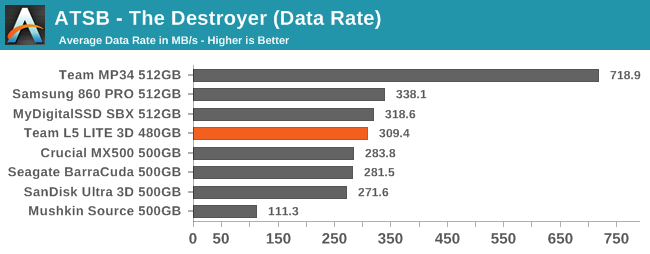 |
|||||||||
| Average Data Rate | |||||||||
| Average Latency | Average Read Latency | Average Write Latency | |||||||
| 99th Percentile Latency | 99th Percentile Read Latency | 99th Percentile Write Latency | |||||||
| Energy Usage | |||||||||
Any expectations that the TeamGroup L5 LITE 3D would perform like an entry-level SSD are shattered by the results from The Destroyer. The L5 LITE 3D has about the best overall data rate that can be expected from a TLC SATA drive. The latency scores are generally competitive with other mainstream TLC SATA drives and unmistakably better than the DRAMless Mushkin Source. Even the energy efficiency is good, though not quite able to match the Samsung 860 PRO.
AnandTech Storage Bench - Heavy
Our Heavy storage benchmark is proportionally more write-heavy than The Destroyer, but much shorter overall. The total writes in the Heavy test aren't enough to fill the drive, so performance never drops down to steady state. This test is far more representative of a power user's day to day usage, and is heavily influenced by the drive's peak performance. The Heavy workload test details can be found here. This test is run twice, once on a freshly erased drive and once after filling the drive with sequential writes.
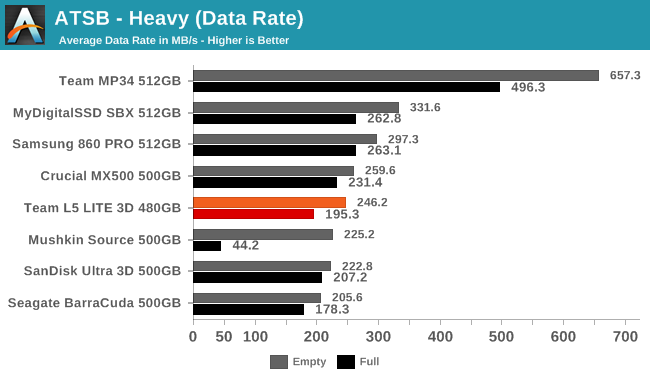 |
|||||||||
| Average Data Rate | |||||||||
| Average Latency | Average Read Latency | Average Write Latency | |||||||
| 99th Percentile Latency | 99th Percentile Read Latency | 99th Percentile Write Latency | |||||||
| Energy Usage | |||||||||
On the Heavy test, the L5 LITE 3D starts to show a few weaknesses, particularly with its full-drive performance—latency clearly spikes and overall throughput drops more than for most mainstream TLC drives. The effect is vastly smaller than the full-drive penalty suffered by the DRAMless competitor. The energy efficiency doesn't stand out.
AnandTech Storage Bench - Light
Our Light storage test has relatively more sequential accesses and lower queue depths than The Destroyer or the Heavy test, and it's by far the shortest test overall. It's based largely on applications that aren't highly dependent on storage performance, so this is a test more of application launch times and file load times. This test can be seen as the sum of all the little delays in daily usage, but with the idle times trimmed to 25ms it takes less than half an hour to run. Details of the Light test can be found here. As with the ATSB Heavy test, this test is run with the drive both freshly erased and empty, and after filling the drive with sequential writes.
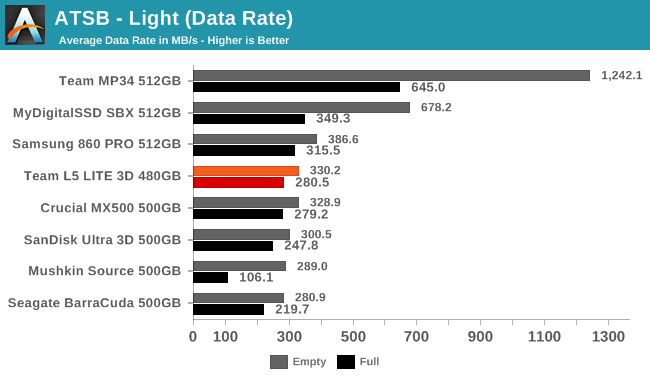 |
|||||||||
| Average Data Rate | |||||||||
| Average Latency | Average Read Latency | Average Write Latency | |||||||
| 99th Percentile Latency | 99th Percentile Read Latency | 99th Percentile Write Latency | |||||||
| Energy Usage | |||||||||
The Team L5 LITE 3D has basically the same overall performance on the Light test as drives like the Crucial MX500. A handful of the latency scores are a bit on the high side, but don't really stand out—the Seagate BarraCuda that uses the old Phison S10 controller with current 3D TLC has more trouble on the latency front, and of course the DRAMless Mushkin Source has by far the worst full-drive behavior. There is a bit of room for improvement on the L5 LITE 3D's energy efficiency, since both the Mushkin Source and Crucial MX500 are clearly better for the empty-drive test runs. The Team drive's efficiency isn't anything to complain about, though.
Burst IO Performance
Our burst IO tests run at a queue depth of one and the amount of data transferred is limited to ensure that SLC write buffers don't fill up and controllers don't overheat. In between each burst there's enough idle time to keep the drive averaging a 20% duty cycle, allowing for some buffered writes and deferred garbage collection to be completed. The random read and write tests use 4kB operations and the sequential tests use 128kB operations. All the burst tests are confined to a 16GB portion of the drive, so DRAMless SSDs are not disadvantaged as much as they are for larger tests.
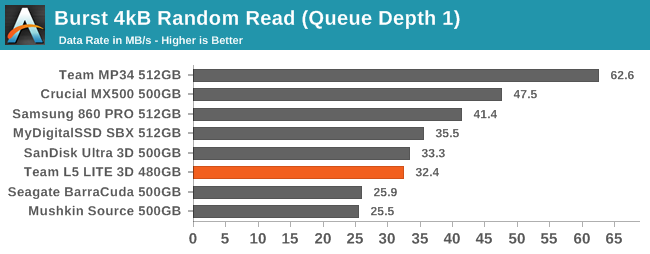 |
|||||||||
| Random Read | Random Write | ||||||||
| Sequential Read | Sequential Write | ||||||||
The SATA SSDs in this bunch all perform very similarly on the burst sequential IO tests, though the TeamGroup L5 LITE 3D is hair slower than the rest for sequential writes. The random write performance is tied for first place among the SATA drives, but the random read performance is much slower than the Crucial MX500.
Sustained IO Performance
Our sustained IO tests measure performance on queue depths up to 32, but the scores reported here are only the averages for the low queue depths (1,2,4) that are most representative of real-world consumer workloads. Each queue depth is tested for up to one minute or 32GB, and the tests are confined to a 64GB span of the drive.
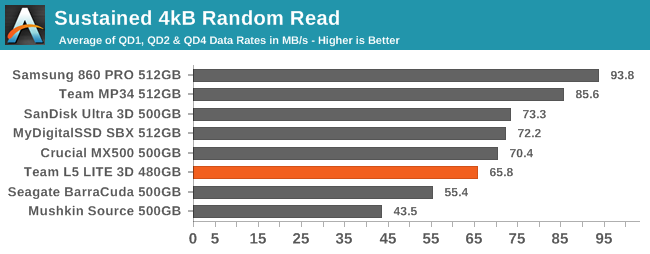 |
|||||||||
| Random Read | Random Write | ||||||||
| Sequential Read | Sequential Write | ||||||||
The Team L5 LITE 3D's sustained sequential performance isn't quite the fastest among the SATA SSDs, but it does stand out for having pretty good performance when performing sequential reads on data that was written with random writes. The random write performance of the L5 LITE 3D is as good as any of the TLC SATA drives in this batch, but the random read performance is a bit slower than the top tier SATA drives.
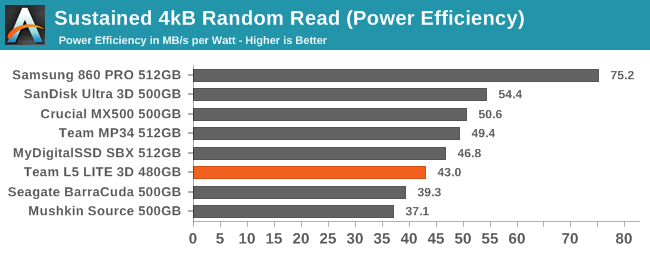 |
|||||||||
| Random Read | Random Write | ||||||||
| Sequential Read | Sequential Write | ||||||||
The L5 LITE 3D's power efficiency during the random write test is pretty good by TLC SATA standards, but otherwise it tends to fall short by a bit. The Mushkin Source DRAMless SATA drive turns in some great efficiency scores thanks to really low power draw (helped by the lack of DRAM), but DRAMless performance on random reads is far too low for it to remain competitive on that efficiency metric.
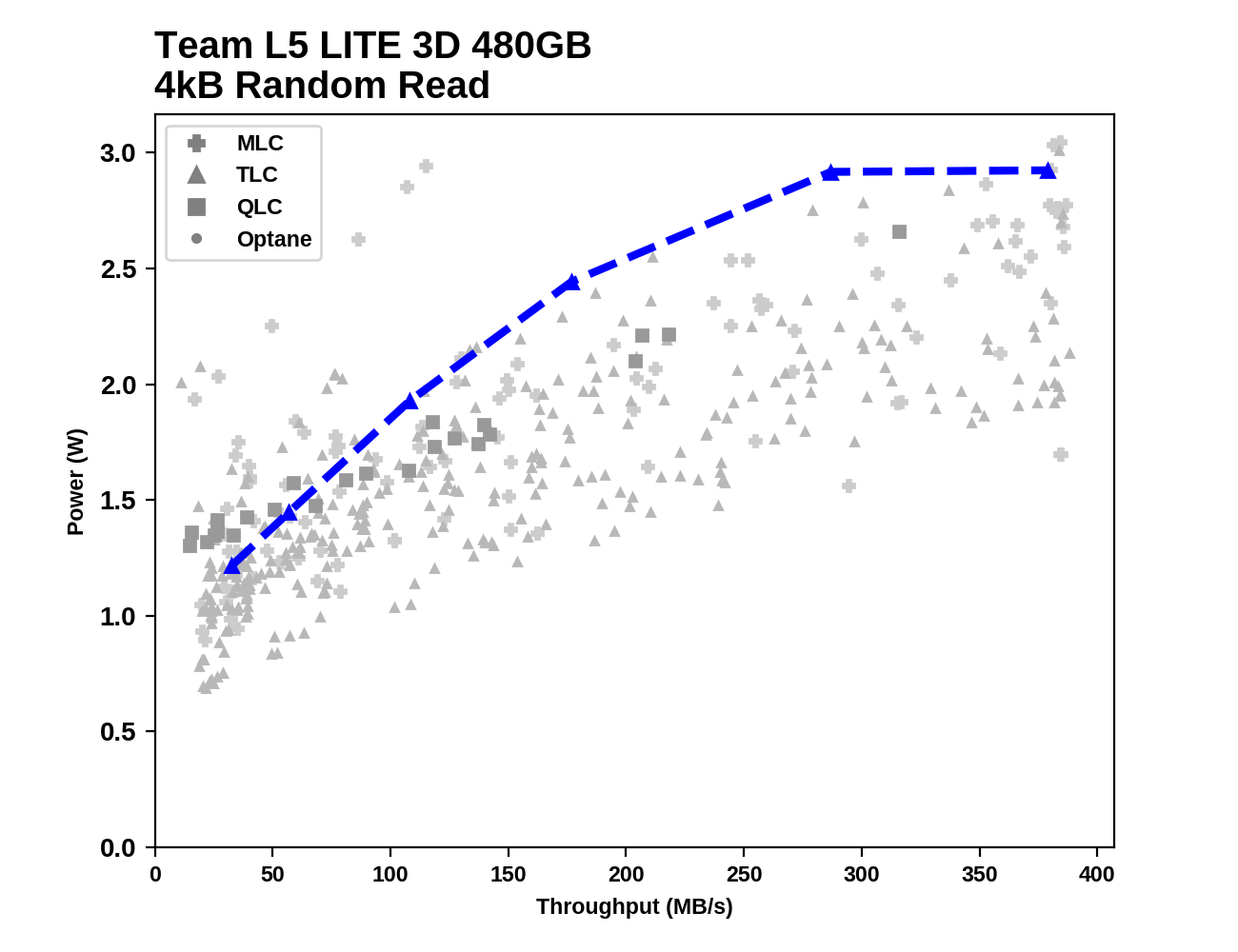 |
|||||||||
| Random Read | Random Write | ||||||||
| Sequential Read | Sequential Write | ||||||||
Plotting the L5 LITE 3D's performance and power at various queue depths against all the other SATA drives in our database shows that the random read power consumption starts to look excessive at medium to high queue depths. For the other workloads, the L5 LITE 3D is at least nowhere near setting a record for good power efficiency, but it does sometimes manage to be better than average.
At high queue depths, the L5 LITE 3D reaches the same SATA throughput limits as everything else for read operations, but the the write speeds top out a bit below the practical maximum for the best SATA SSDs.
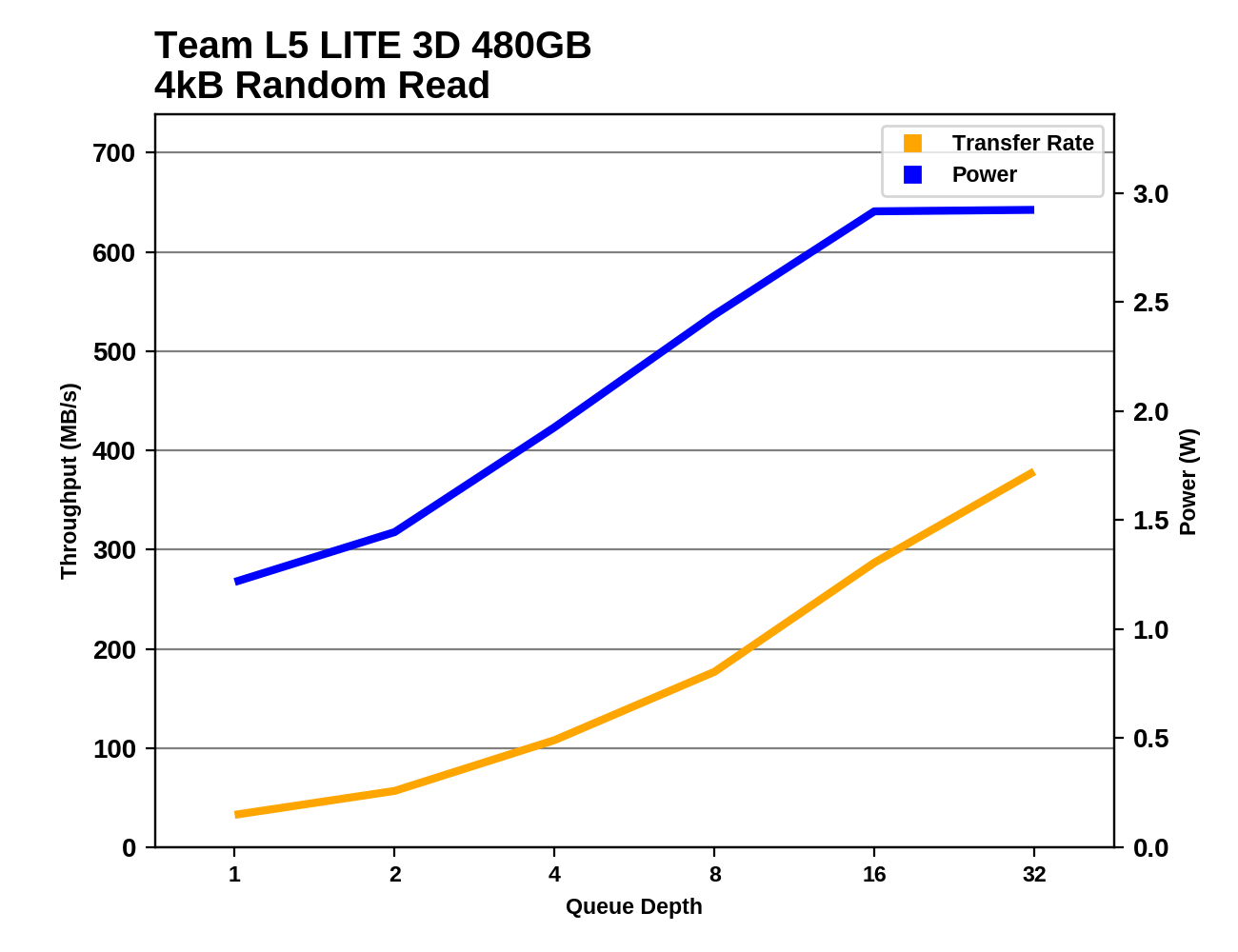 |
|||||||||
| Random Read | |||||||||
| Random Write | |||||||||
| Sequential Read | |||||||||
| Sequential Write | |||||||||
Putting the L5 LITE 3D head to head against other TLC SATA drives makes it clear that the Team drive can almost always hold its own on the performance front. The power consumption is where it loses, and sometimes by a pretty wide margin: the Mushkin Source is a full 1W ahead of the L5 LITE 3D for sequential writes, and the Crucial MX500 is ahead by about 0.5W for random reads at high queue depths.
Whole-Drive Fill
This test starts with a freshly-erased drive and fills it with 128kB sequential writes at queue depth 32, recording the write speed for each 1GB segment. This test is not representative of any ordinary client/consumer usage pattern, but it does allow us to observe transitions in the drive's behavior as it fills up. This can allow us to estimate the size of any SLC write cache, and get a sense for how much performance remains on the rare occasions where real-world usage keeps writing data after filling the cache.
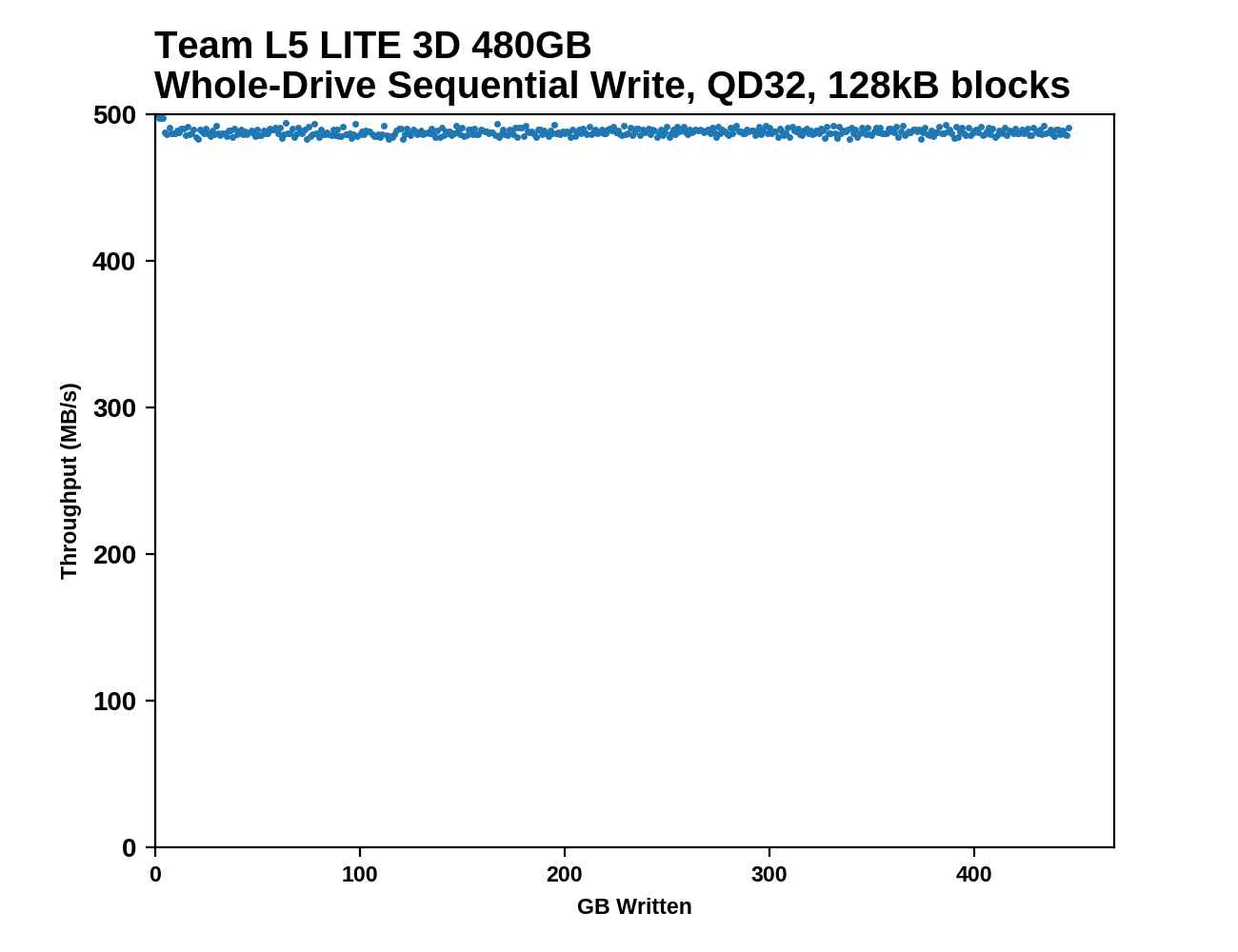 |
|||||||||
The ATSB tests already showed that the TeamGroup L5 LITE 3D doesn't lose much performance when it is full, but actually plotting its performance through the process of filling it up is surprising. The sequential write throughput does drop slightly after about 5GB, but only by 10-15MB/s, and there are no further performance drops for the rest of the fill process. This is a lot more consistent than most drives, and provides more evidence that SLC caches running out aren't a problem for this SSD.
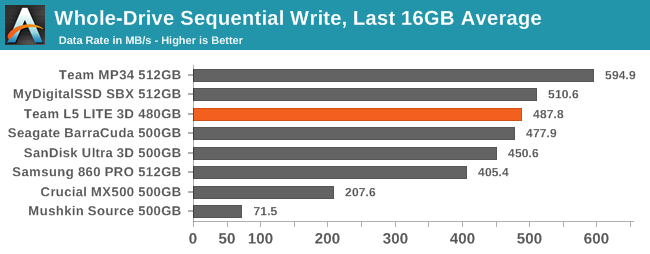 |
|||||||||
| Average Throughput for last 16 GB | Overall Average Throughput | ||||||||
Working Set Size
When DRAMless SSDs are under consideration, it can be instructive to look at how performance is affected by working set size: how large a portion of the drive is being touched by the test. Drives with full-sized DRAM caches are typically able to maintain about the same random read performance whether reading from a narrow slice of the drive or reading from the whole thing. DRAMless SSDs often show a clear dropoff when the working set size grows too large for the mapping information to be kept in the controller's small on-chip buffers.
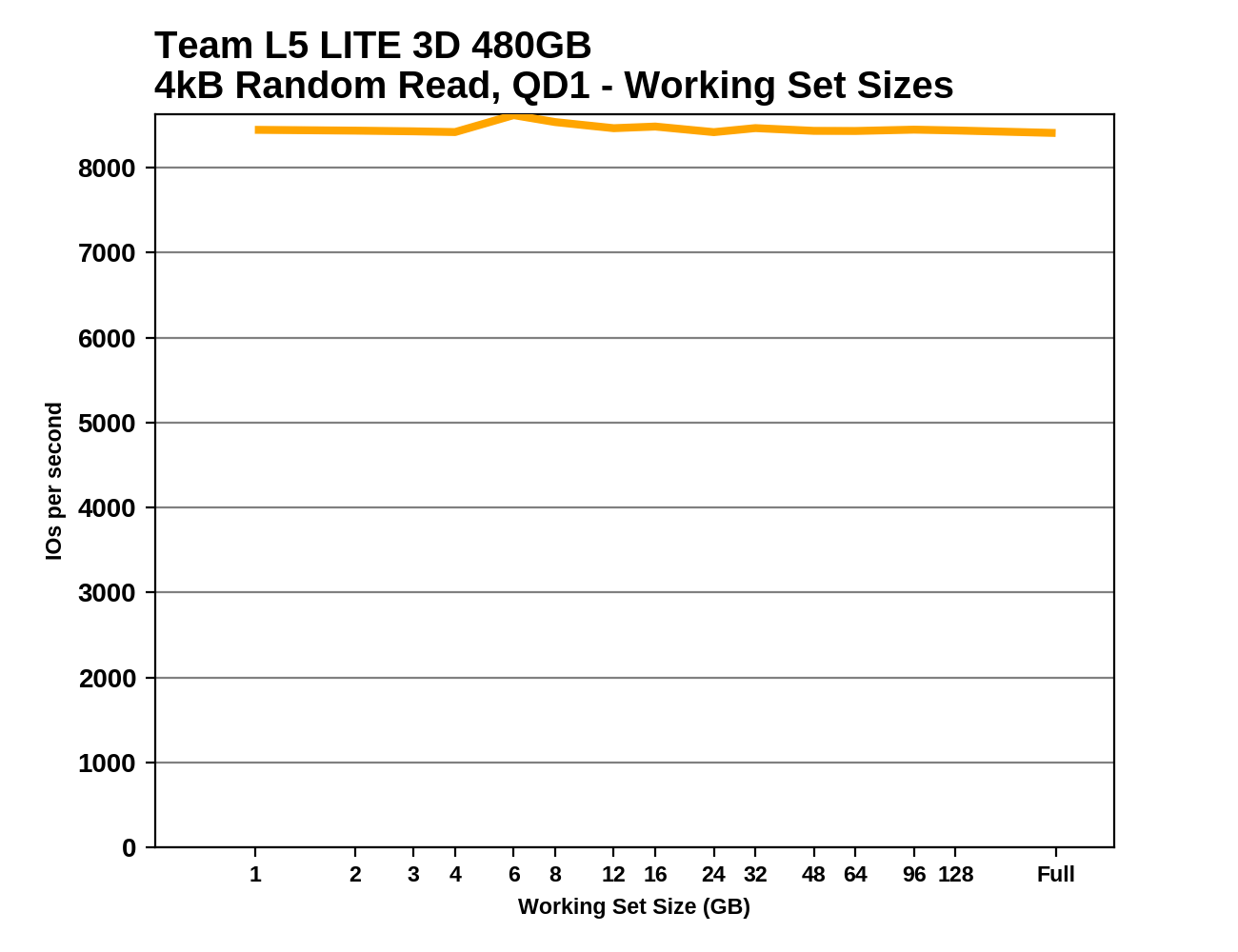 |
|||||||||
As expected, the L5 LITE 3D maintains fairly steady random read performance regardless of working set size. The DRAMless Mushkin Source starts off with significantly lower random read IOPS and declines even more as working set sizes grow to more than a few GB of active data. The three drives here with Phison controllers (one SATA, two NVMe) all show at least some decline in performance with large working set sizes, even though those drives all have the usual 1GB DRAM to 1TB NAND ratio.
Mixed I/O Performance
Our tests of mixed read/write IO vary the workload from pure reads to pure writes at 10% increments. Each mix is tested for up to 1 minute or 32GB of data transferred. The mixed random IO test uses a queue depth of 4 while the mixed sequential IO test uses a queue depth of 1. The tests are confined to a 64GB span of the drive, and the drive is given up to one minute of idle time in between each mix tested.
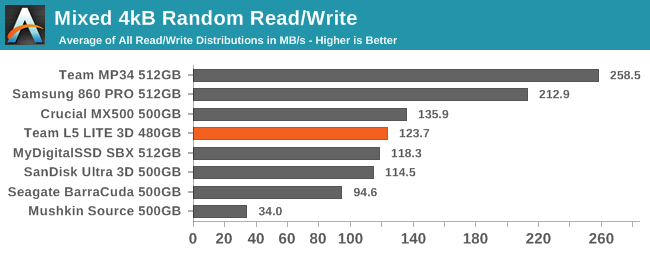 |
|||||||||
| Mixed Random IO | Mixed Sequential IO | ||||||||
The mixed sequential IO performance of the TeamGroup L5 LITE 3D is as good as any other SATA drive, and on the mixed random test it's only slightly slower overall than the Crucial MX500, the fastest TLC SATA drive in this bunch.
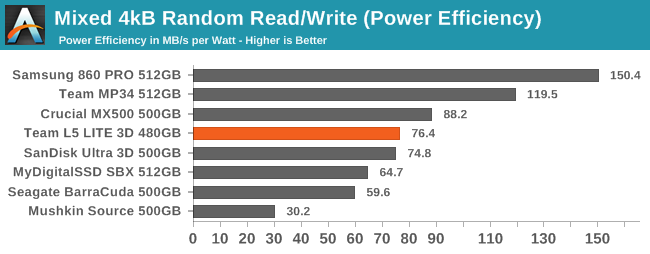 |
|||||||||
| Mixed Random IO | Mixed Sequential IO | ||||||||
The power efficiency of the L5 LITE 3D during the mixed IO tests is average or slightly better. In both cases there's a TLC SATA drive with a substantial efficiency advantage, and the Samsung 860 PRO sets a high bar for efficiency.
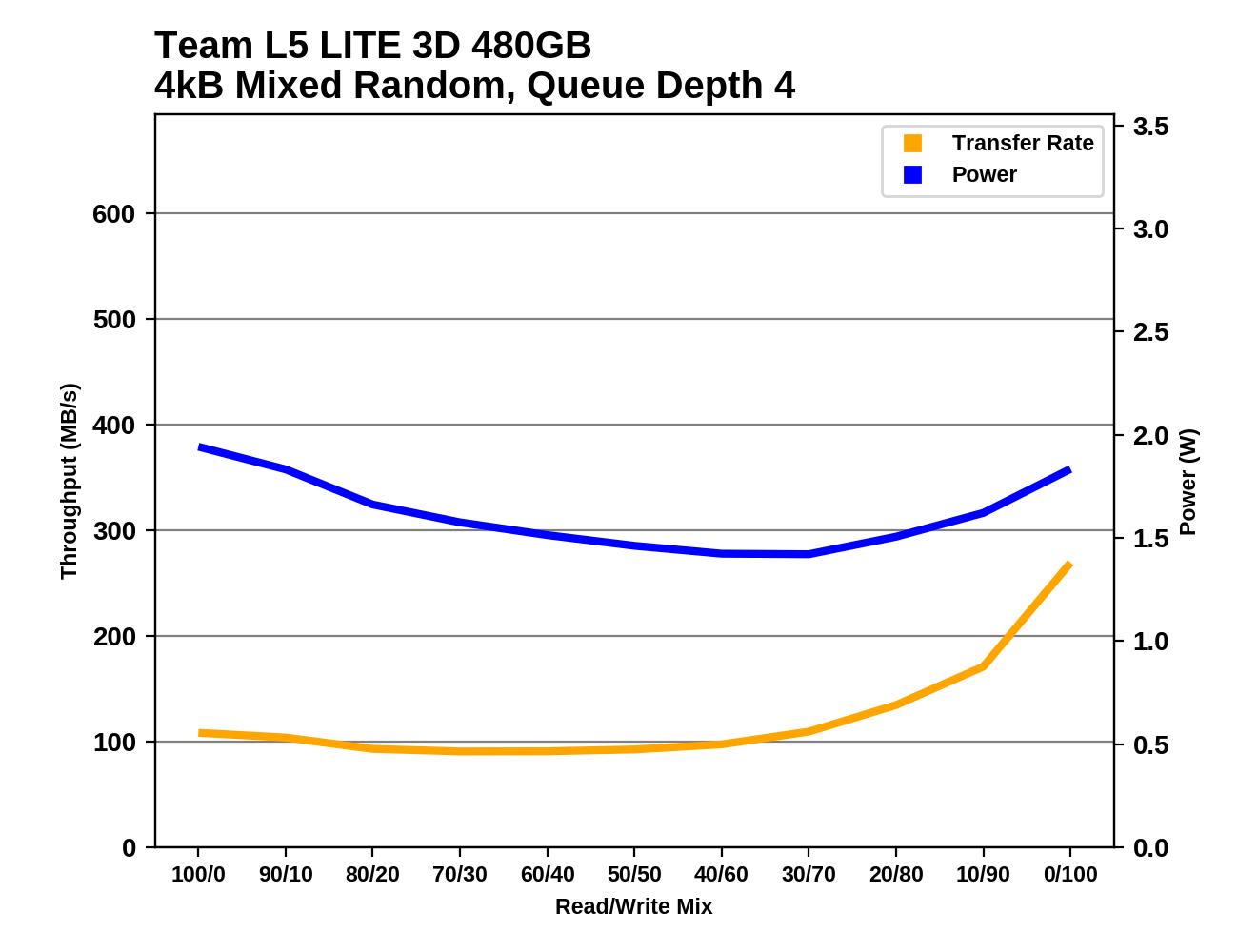 |
|||||||||
| Mixed Random IO | |||||||||
| Mixed Sequential IO | |||||||||
The performance profiles for the L5 LITE 3D on the mixed IO tests are both fairly typical for mainstream SATA drives. The random IO performance is fairly flat until the workload is at least 70% writes, then it starts to pick up the pace. The sequential IO performance is more of a gradual decline as the workload shifts more toward writes.
Idle Power Measurement
SATA SSDs are tested with SATA link power management disabled to measure their active idle power draw, and with it enabled for the deeper idle power consumption score and the idle wake-up latency test. Our testbed, like any ordinary desktop system, cannot trigger the deepest DevSleep idle state.
Note: We recently upgraded our power measurement equipment and switched to measuring idle power on our Coffee Lake desktop, our first SSD testbed to have fully-functional PCIe power management. The below measurements are all new, and are not a perfect match for the older measurements in our previous reviews and the Bench database.
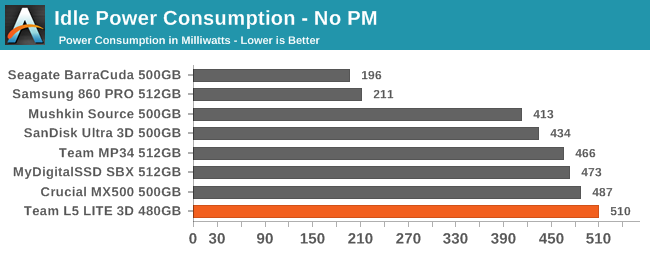
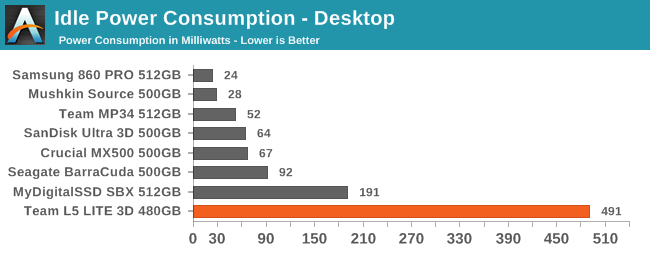
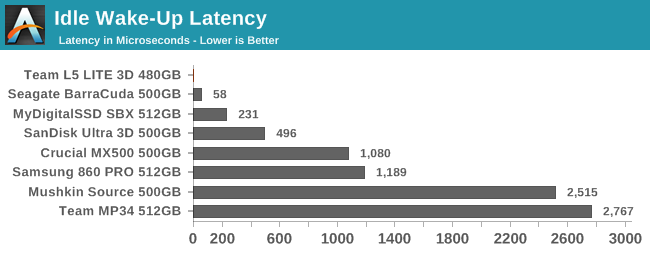
The active idle power consumption of the TeamGroup L5 LITE 3D is higher than most SSDs, but not by much. Unfortunately, enabling power management barely has any effect. The L5 LITE 3D doesn't appear to have functional SATA Link Power Management. The only upside here is that without working power management, there's no extra latency when waking up. (It's possible that DevSleep power management might work on the L5 LITE 3D, but that feature cannot be tested on a desktop system.)
Conclusion
The SATA SSD market is pretty boring these days, and just about the only way for a product to stand out is to be significantly cheaper than the competition. Sometimes we see one of the top brands use the advantages of their vertical integration to price a great product low enough to shut out lots of lesser entry-level drives. It's relatively rare that we see the same tactic pulled off by a smaller fabless OEM. For most of its time on the market, the TeamGroup L5 LITE 3D has been one of the cheapest drives in the North American market. The low pricing alone was reason enough for me to ask Team to send one my way last time they were offering up SSDs for review. The L5 LITE 3D didn't disappoint.
The performance profile of the Team L5 LITE 3D generally fits what we expect from a mainstream SATA SSD rather than an entry-level drive. None of our tests revealed any significant performance loss from the SLC cache filling up, and running our ATSB Heavy and Light tests on a full drive didn't bring it to its knees. The only negative result that really stands out is with random reads, which are both slower and more power-hungry than what we see with competing SATA drives from top-tier brands like Crucial, WD and Samsung. Even then, the difference is most pronounced at higher queue depths that are less likely to be encountered during typical real-world usage.
The Team L5 LITE 3D's power consumption under load is generally a bit high, but not enough to worry about. What is a real problem is that idle power management doesn't work as it should—it idles around 0.5W with or without SATA link power management. It's impossible for us to test whether the deeper DevSleep mode works properly since our testbed is a desktop system, but the intermediate Slumber state should be able to get the drive well under 0.1W.
The Team L5 LITE 3D is a decent choice for a desktop that is overdue for an upgrade to its first SSD, and it's a very affordable way to add a second SSD to a system where the primary SSD is getting full. The power management issues make it a poor choice to go into a laptop, and for an all-new desktop build the primary SSD should probably be a NVMe drive rather than SATA except where the budget is extremely tight. For users with fairly light storage workloads, the low write endurance of the L5 LITE 3D should still be plenty, and it's probably a more sensible tradeoff than the sometimes steep performance penalty of DRAMless SATA SSDs.
While SSD prices were still in freefall, the L5 LITE 3D was leading the charge and occasionally standing out to a degree we haven't seen since the Mushkin Reactor first made 1TB SSDs relatively affordable back in the planar NAND days. Now that SSD prices have leveled out, the Team L5 LITE 3D doesn't stand out as much, but it's still a good deal for a cheap SSD that doesn't really feel cheap.

